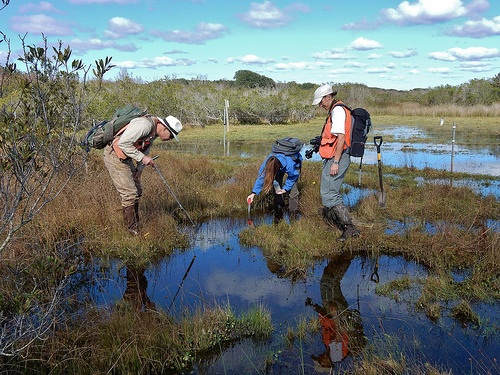On April 30, the US Environmental Protection Agency (EPA) published a proposed rule (40 CFR part 30) to “strengthen transparency in regulatory science” by requiring the agency to make the data and models used for significant regulatory decisions available for public and peer review. Like most things regarding EPA these days, the proposal has generated significant controversy – based to a large extent to whether the commenter puts more trust in the proposed system and today’s EPA, or in the existing system and yesterday’s EPA. In the remainder of this blog I’ll discuss what’s nominally involved, and possible adjustments to narrow the opportunities for manipulation by tomorrow’s EPA.
Read MoreAudit, Compliance and Risk Blog
EPA’s Data Transparency Proposal – Secrets are in the Eye of the Beholder
Posted by Jon Elliott on Thu, May 03, 2018
Tags: Environmental risks, Environmental, EPA
The Resource Conservation and Recovery Act (RCRA) assigns the US Environmental Protection Agency (EPA) to define and then regulate “hazardous wastes.” RCRA provides EPA considerable discretion, and one way the agency applies that discretion is by separating hazardous wastes into a variety of categories that are subject to distinct waste management requirements. One basis for these categorizations is relative risk – the more hazardous the waste the greater the controls required, and the smaller the threshold quantities necessary to trigger regulation. Beginning in 1995, EPA has defined a limited set of lower-risk wastes as “universal wastes” subject to special rules intended to encourage recycling (40 CFR part 273). In March 2018, EPA proposed to add aerosol cans. The rest of this note summarizes universal waste requirements, and how EPA is proposing to apply them to aerosol cans.
Read MoreTags: Environmental risks, Environmental, EPA, Hazcom
A lot of time is spent shopping for the right look and for fashion that will flatter or get attention, but are we spending our dollars wisely to make sure that the clothes we wear today will not damage the environment in other parts of the world or in our own backyards tomorrow?
Read MoreTags: Environmental risks, Environmental, Hazcom, sustainability, corporate social responsibility
Administration Proposes Massive Cuts in EPA for Fiscal Year 2019
Posted by Jon Elliott on Tue, Mar 27, 2018
On February 12, the Trump Administration issued its budget proposal for federal Fiscal Year (FY) 2019 (October 1, 2018 through September 30, 2019), subtitled “An American Budget”. The proposal included a 34% cut in the Environmental Protection Agency (EPA) budget, from $8.2 billion in FY 2016 (stable in FY 2017 and FY 2018 under a Continuing Budget Resolutions rather than a fully-new federal budget), to $5.4 billion for FY 2019, with corresponding personnel cuts from 15,408 full-time-equivalent employees (FTE) to 12,250. (these are numbers for EPA in the government-wide budget from the Office of Management and Budget (OMB); the stand-alone budget document on EPA’s website cites $6.1 billion).
Read MoreTags: Business & Legal, Environmental risks, Environmental, EPA, climate change
EPA Issues Annual Chemical Review Plan Under the 2016 Amendments to TSCA
Posted by Jon Elliott on Tue, Mar 13, 2018
The Environmental Protection Agency (EPA) has published its second Annual Plan for Chemical Risk Evaluations. These evaluation workplans are required by the 2016 Lautenberg Act amendments to the Toxic Substances Control Act (TSCA), as an expansion of EPA’s long-criticized efforts to evaluate existing chemicals for potential health and safety hazards. This new Annual Plan updates EPA’s efforts since 2016, and continues to formalize procedures.
Read MoreTags: Environmental risks, Environmental, EPA, Hazcom, tsca
EPA’s Latest National TRI Inventory Shows Continuing Reductions in Releases
Posted by Jon Elliott on Thu, Mar 08, 2018
The US Environmental Protection Agency (EPA) requires selected facilities to file Toxic Release Inventory (TRI) reports on either Form R or Form A, electronically to EPA and their state every July 1. These TRI reports are mandated by Section 313 of the Emergency Planning and Community Right-to-Know Act of 1986 (EPCRA; also known as SARA Title III since it was enacted as part of the Superfund Amendments and Reauthorization Act of 1986). (I summarized TRI reporting requirements here).
Read MoreTags: Environmental risks, Environmental, EPA, Hazcom
EPA Withdraws “Once in Always in” Policy For Major Air Toxics Sources
Posted by Jon Elliott on Tue, Mar 06, 2018
The Clean Air Act (CAA) directs the Environmental Protection Agency (EPA) to define “hazardous air pollutants (HAPs)” that may pose acute health hazards, and to impose regulations to reduce those hazards. Controls include permits for “major sources” of HAPs based on “Maximum Achievable Control Technologies (MACT),” and lesser controls for non-major “area sources.” Since 1995, EPA policy has been that every emission source that met major source criteria at the time a MACT became effective is “once in, always in” and cannot requalify as a less-regulated area source even if it accepts legally binding controls that reduce its “potential to emit.” On January 25, 2018 EPA reversed that decades-old policy.
Read MoreTags: Environmental risks, Environmental, EPA, Greenhouse Gas, ghg, climate change, CAA, mact
California Adopts Plan for Greenhouse Gas Controls Through 2030
Posted by Jon Elliott on Tue, Feb 27, 2018
Since enacting AB 32 in 2006, California has pursued aggressive policies to reduce statewide greenhouse gas (GHG) emissions. Primary responsibilities are assigned to the California Air Resources Board (ARB), although other state agencies implement complementary policies within their areas of special jurisdiction. In addition to emissions control regulations, state law assigns ARB to develop a Scoping Plan that identifies the state’s strategic goals, and compiles the many tactical approaches through individual regulatory and incentive programs. ARB issued the first Scoping Plan in 2008, with an update in 2014 and the latest update in 2017. The rest of this note describes changes in the latest Scoping Plan to reflect the state’s ever-expanding GHG reduction goals.
Read MoreTags: Health & Safety, California Legislation, Environmental risks, Environmental, Greenhouse Gas, ghg
Regional Greenhouse Gas Initiative Extends Efforts Until 2030
Posted by Jon Elliott on Tue, Feb 13, 2018
One of the longest running sub-national greenhouse gas (GHG) control efforts in the U.S. has been the Regional Greenhouse Gas Initiative (RGGI) program. RGGI provides a cap-and-trade program covering GHG emissions from targeted fossil fuel power plants in participating northeastern states. The program t has just been revised and extended through 2030.
Read MoreTags: Environmental risks, Environmental, Greenhouse Gas, ghg, cap-and-trade
On June 22, 2016 President Obama signed the “Frank R. Lautenberg Chemical Safety for the 21st Century Act,” revising the Toxic Substances Control Act (TSCA) TSCA extensively. I’ve written about the major programmatic changes here, here, and here. In addition to those Big Picture changes however, the 2016 Amendments provide a number of targeted revisions.
Read MoreTags: Health & Safety, Environmental risks, Environmental, Hazcom, tsca










